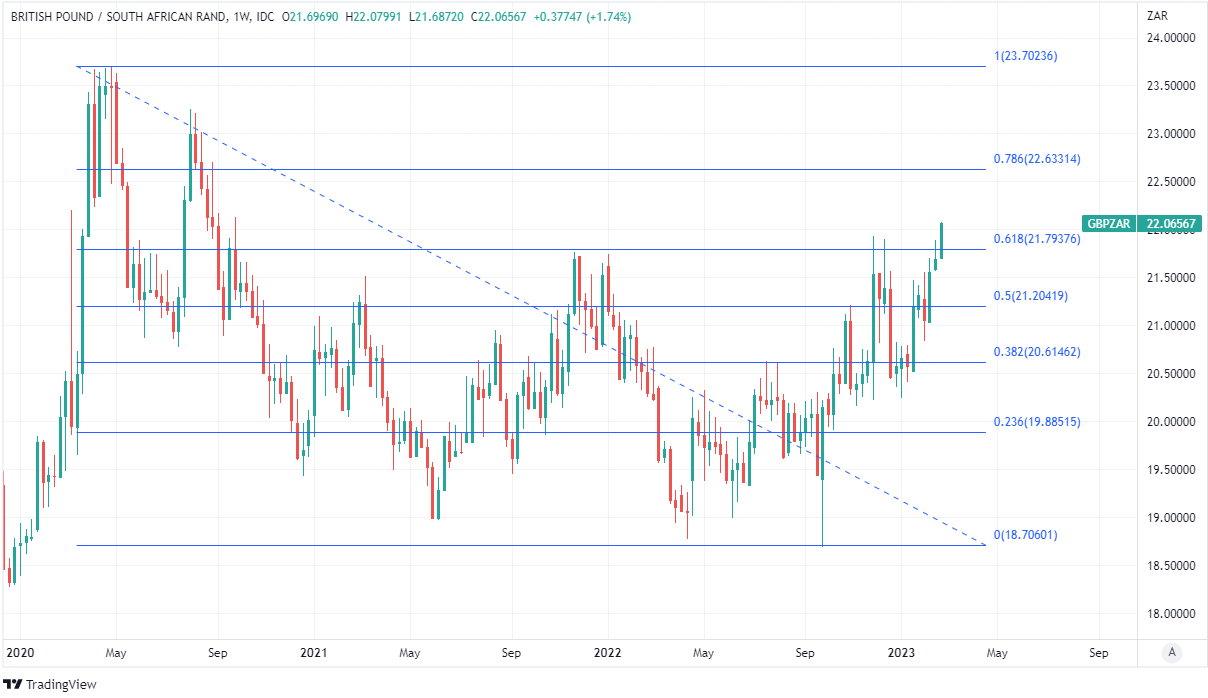Pound to South African Rand Rate Climbs as Energy Woe Risks Economic Disaster
"The market focus will be on the budget speech later in the week; any rand strength is likely to be met with demand for USD ahead of this event" - Nedbank.

Image © Adobe Images
The Pound to Rand exchange rate reached 18-month highs early in the new week amid a broad rally in Sterling and widespread losses for the Rand but GBP/ZAR could potentially top 22.40 in the days ahead as South Africa's energy crisis risks fomenting an economic disaster.
Pound Sterling rallied against all counterparts in the G20 basket on Tuesday as it mirrored a sharp increase in S&P Global PMI survey indices suggesting the UK economy returned to growth in February following large declines in energy prices during earlier months.
GBP/ZAR was the biggest riser in the Sterling exchange rate complex as the Rand fell widely after state energy monopoly Eskom announced that it would implement Stage 6 loadshedding due to an unprecedented and economically crippling number of equipment failures on Sunday.
#POWERALERT2
— Eskom Hld SOC Ltd (@Eskom_SA) February 19, 2023
Due to the breakdowns of eight generation units on Sunday afternoon, Stage 6 loadshedding will be implemented continuously until further notice. pic.twitter.com/57F78z93IO
"This adds to negative market sentiment towards SA," says Annabel Bishop, chief economist at Investec.
Loss of power generation amounts to almost 25,000MW and is equal to something like half of all of South Africa's total power generation capacity.
 Above: Pound to Rand rate shown at weekly intervals with Fibonacci retracements of 2020 downtrend indicating possible areas of technical resistance. Click image for closer inspection.
Above: Pound to Rand rate shown at weekly intervals with Fibonacci retracements of 2020 downtrend indicating possible areas of technical resistance. Click image for closer inspection.
Stage 6 loadshedding imposes rolling powercuts on the country and economy for up to 10 hours at a time, and is so far the most severe level seen in South Africa, although local media are warning there is a risk of a shift to an unprecedented Stage 8 involving up to 14 hours of power cuts per day.
"President Cyril Ramaphosa declared the electricity situation a state of disaster, which seemed to aggravate global investors even further as the ZAR failed to hold on to any material gains," says Sebastian Steyne, an FX risk and hedging specialist at Sable International, in reference to the governmental response.
"The South African inflation rate decreased on a month-on-month basis, which points to some temporary relief to consumers. However, as the currency weakens, this will filter through into higher energy prices once again, leading to future inflation," Steyne warned in a Monday market commentary.
The present bout of Stage 6 loadshedding is set to continue "until further notice" and comes ahead of Wednesday's annual budget, which is to be announced in parliament by Finance Minister Enoch Godongwana.
"The market focus will be on the budget speech later in the week; any rand strength is likely to be met with demand for USD ahead of this event. Possible trading range for the rand [USD/ZAR] today: 17,9000 to 18,3000," says Walter de Wet, a fixed income and currency strategist at Nedbank.
 Above: USD/ZAR shown at weekly intervals with Fibonacci retracements of 2020 downtrend indicating possible areas of technical resistance. Click image for closer inspection. (If you are looking to protect or boost your international payment budget you could consider securing today's rate for use in the future, or set an order for your ideal rate when it is achieved, more information can be found here.)
Above: USD/ZAR shown at weekly intervals with Fibonacci retracements of 2020 downtrend indicating possible areas of technical resistance. Click image for closer inspection. (If you are looking to protect or boost your international payment budget you could consider securing today's rate for use in the future, or set an order for your ideal rate when it is achieved, more information can be found here.)
South Africa's energy crisis is an increasingly heavy burden for the public purse and the risk is that related measures announced in Wednesday's budget will weigh heavier on the Rand, potentially leading GBP/ZAR to rise further.
Much about the outlook for GBP/ZAR also depends on USD/ZAR, increases in which can have the effect of lifting GBP/ZAR, which would potentially top 22.40 if both Sterling and the Dollar continue to climb in broad terms.
USD/ZAR has been lifted sharply in recent trade by both South Africa's domestic economic troubles as well as a broad rally in the U.S. Dollar, which appears to have benefited from increases in U.S. bond yields and an uplift in market expectations for the Federal Reserve (Fed) interest rate.
"Better than anticipated data on the health of the US economy, and building market concerns over a more hawkish Fed approach has added volatility to the rand, which has lost ground too as the interest rate differential between the US and SA eroded," Investec's Bishop says.
"SA has only hiked by 375bp to date, and the FOMC by 450bp, with the rand weakening materially as a consequence as the return on risk diminished comparatively, eroding the protective buffer," she adds.
